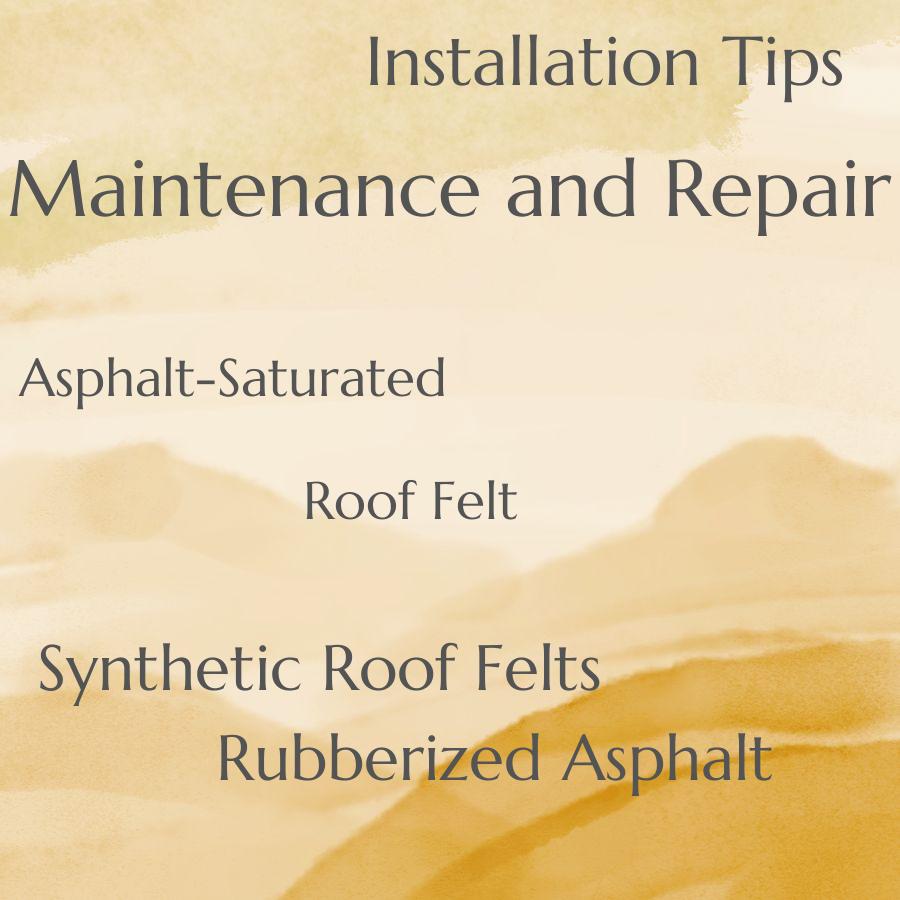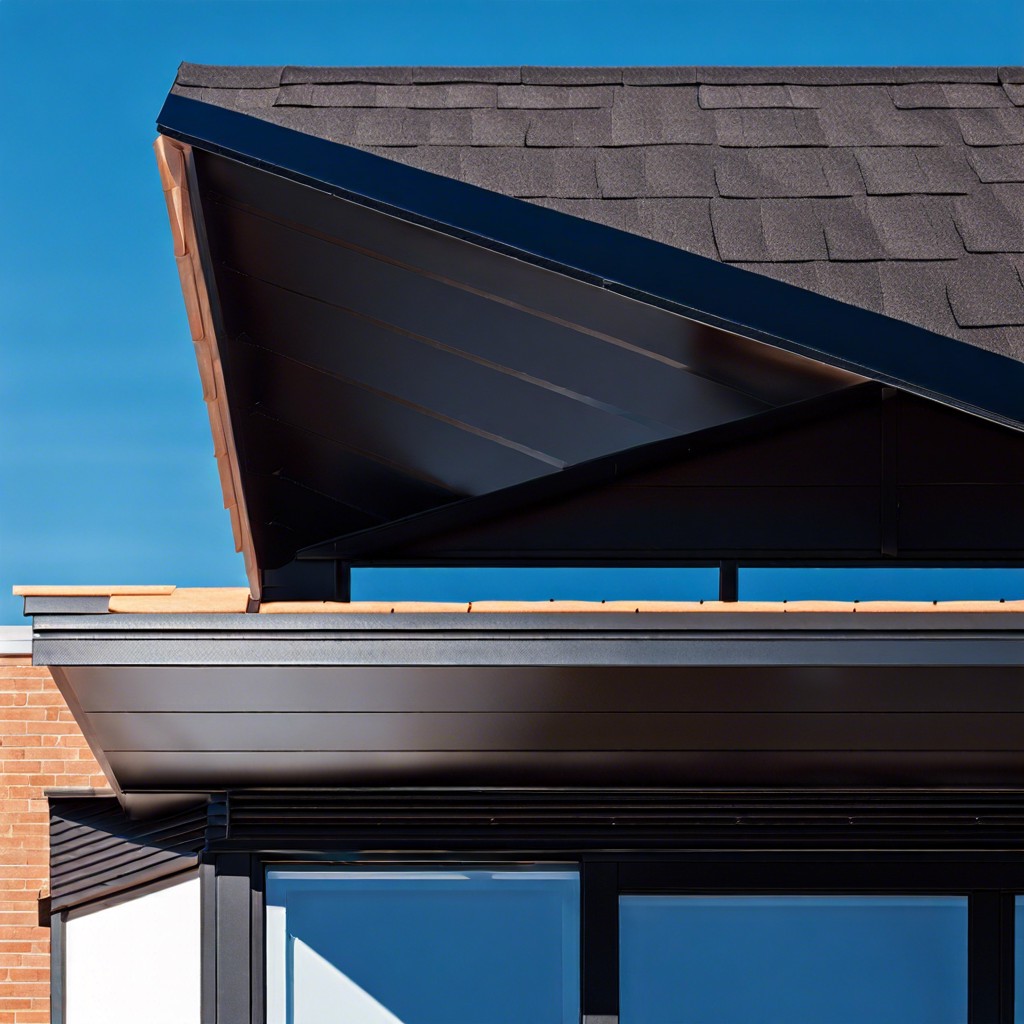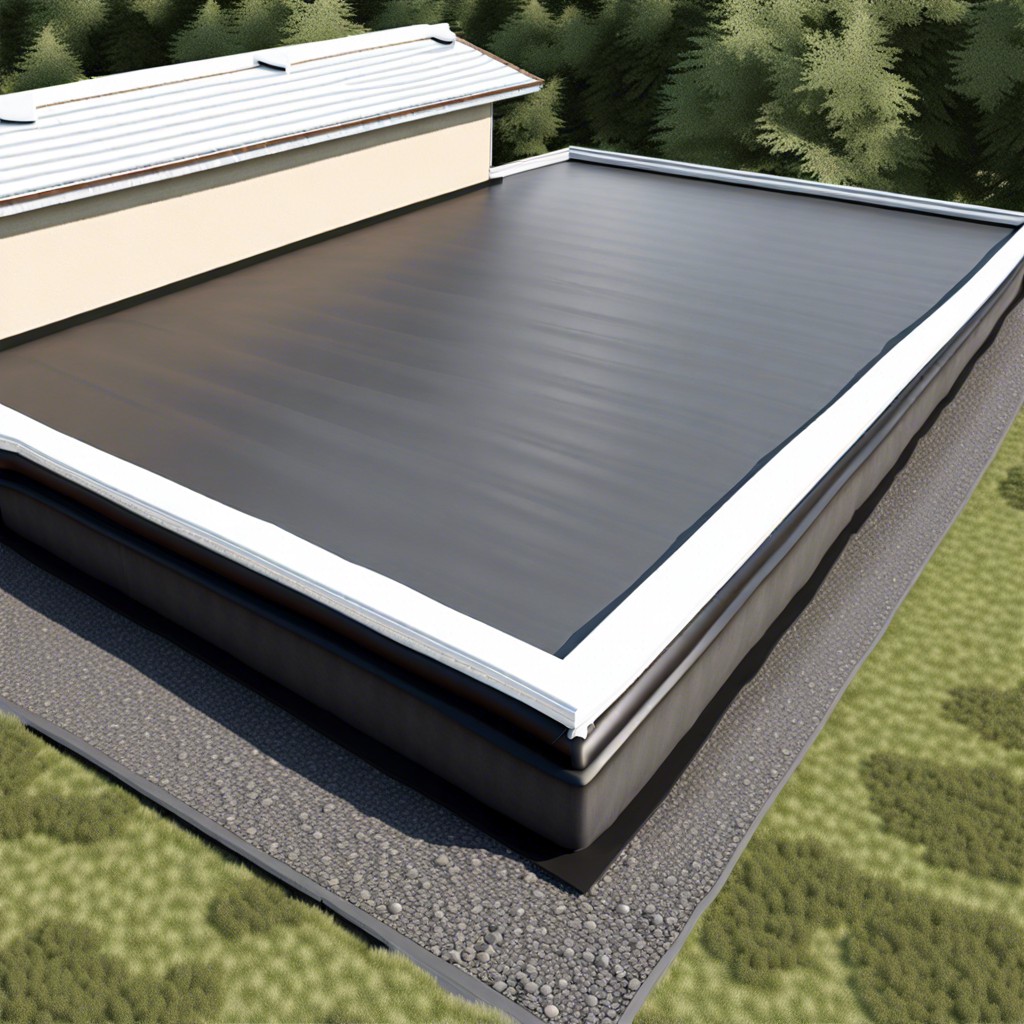Last updated on
Explore the versatile world of roof felt as we dive into its various types, enhancing your home’s protection and aesthetics.
Are you planning to install a new roof or repair an existing one? If so, you might have come across the term “roof felt.” Roof felt is an essential component of any roofing system, as it provides a protective layer between the roof deck and shingles. But did you know that there are different types of roof felt available in the market? Each type has its unique features and benefits.
In this article, we’ll explore the various types of roof felt and help you choose the right one for your roofing needs. So, let’s dive in!
Introduction to Roof Felt

Roof felt, also known as roofing underlayment or tar paper, is a thin layer of material that is installed between the roof deck and shingles. It serves as an additional barrier against moisture and helps to protect your home from water damage.
Roof felt has been used in roofing systems for over a century and has evolved into different types with varying features.
Asphalt-saturated felt was the first type of roof felt introduced in the market. It consists of organic or fiberglass matting that is saturated with asphalt to make it waterproof.
Rubberized asphalt came next, which added rubber polymers to improve its flexibility and durability.
Synthetic roof felts are relatively new but have gained popularity due to their superior performance compared to traditional felts. They are made from synthetic materials such as polypropylene or polyester fibers coated with asphalt for waterproofing.
Choosing the right type of roof felt depends on various factors such as climate conditions, budget constraints, personal preferences among others.
Asphalt-Saturated Felt
It’s made from a base material of organic or fiberglass mat that’s saturated with asphalt to make it waterproof. The asphalt coating gives the felt its characteristic black color and makes it resistant to water and UV rays.
One advantage of using asphalt-saturated felt is its affordability compared to other types of roof underlayment. It’s also easy to install since it can be nailed down directly onto the roof deck without any special equipment or tools.
However, one disadvantage is that this type of felts tends to dry out over time due to exposure from sunlight and heat which may cause cracking leading water penetration into your home causing damage such as mold growth on walls or ceilings.
Rubberized Asphalt
It is made by adding recycled rubber to the asphalt mix, which enhances its strength and resistance to weathering. Rubberized asphalt also provides better insulation than traditional felt, making it an excellent choice for homes located in areas with extreme temperatures.
One of the significant advantages of rubberized asphalt is that it can be used on both low-slope and steep-slope roofs. Its flexibility allows it to conform easily around corners, edges, and other irregular shapes without cracking or tearing.
Another benefit of using rubberized asphalt as your roofing underlayment material is that it helps reduce noise transmission from outside sources such as rain or hail hitting the roof surface. This feature makes it ideal for homes located near busy roads or airports where noise pollution can be a problem.
However, like any roofing material, there are some disadvantages associated with using rubberized asphalt as well. One potential drawback could be its cost compared to traditional felt options; however many homeowners find this investment worthwhile given their long-lasting benefits.
Synthetic Roof Felts
These are made from materials like fiberglass or polyester and coated with asphalt to make them waterproof. Synthetic roof felts offer several advantages over traditional felt, including better tear resistance, UV protection, and improved moisture control.
One of the most significant benefits of synthetic roof felts is their longevity. They can last up to three times longer than traditional felt underlayment due to their superior strength and durability.
They are lightweight yet strong enough to withstand harsh weather conditions such as heavy rain or snowfall.
Another advantage is that they come in larger rolls compared to traditional felt underlayment which means fewer seams during installation resulting in less chance of water penetration through joints.
However, it’s important not just choosing any type of synthetic roofing material but one that meets your specific needs based on factors such as climate zone where your home is located among others.
Choosing the Right Roof Felt
The type of roofing material you have, your budget, and the climate in your area are all important considerations.
Asphalt-saturated felt is a popular choice for traditional asphalt shingle roofs. It’s affordable and provides good protection against moisture.
Rubberized asphalt is another option that offers better resistance against water damage and has a longer lifespan than traditional felt.
Synthetic roof felts made from materials like fiberglass or polyester offer superior durability compared to their organic counterparts. They’re also more resistant to tearing and punctures.
Consider the weather conditions in your area when selecting a roof felt material as well. If you live in an area with high humidity or frequent rainstorms, choose a product that can withstand moisture without deteriorating quickly.
Advantages and Disadvantages
One of the main benefits of using roof felt is that it provides an extra layer of protection to your home against water damage, which can be particularly useful in areas with heavy rainfall or snowfall. Some types of roof felts are designed to resist UV rays and high temperatures.
Another advantage is that most types of roof felts are relatively easy to install compared to other roofing materials like metal or tile roofs. This makes them a popular choice for DIY enthusiasts who want to save money on installation costs.
However, there are also some downsides associated with using certain types of roof felts. For example, asphalt-saturated felt can be prone to tearing during installation if not handled carefully due to its brittle nature when cold.
Moreover, synthetic underlayment may have a higher upfront cost than traditional asphalt-saturated underlayment but offers better durability over time as well as resistance against moisture penetration from wind-driven rain events.
Installation Tips
Proper installation is crucial to ensure that your roof provides maximum protection against weather elements and lasts longer. Here are some installation tips that can help:
1. Clean the Roof Deck: Before installing the roof felt, make sure that the surface is clean and free from debris or any sharp objects.
2. Use Appropriate Fasteners: Use nails or staples recommended by manufacturers for fastening felts onto roofs.
3. Overlap Correctly: Make sure to overlap each row of felt correctly as per manufacturer instructions.
4. Avoid Wrinkles and Bubbles: Smooth out wrinkles or bubbles in between layers while installing felts on a sloped surface.
5. Cut Carefully Around Obstacles: When cutting around obstacles like vents, chimneys, etc., be careful not to damage them while ensuring proper coverage with felts.
Maintenance and Repair
However, like any other roofing material, it requires regular maintenance to ensure its longevity. One of the most common issues with roof felt is water damage caused by leaks or moisture buildup.
If you notice any signs of water damage on your roof felt, such as discoloration or mold growth, it’s essential to address the issue immediately. Ignoring these problems can lead to more significant issues down the line and compromise your home’s structural integrity.
To repair minor damages in your roof felt, you’ll need some basic tools such as a utility knife and roofing cement. Start by cutting out damaged sections of the underlayment using a utility knife carefully.
Then apply roofing cement over the exposed area before laying new pieces of underlayment over it.
For major repairs or replacement needs beyond DIY capabilities; we recommend hiring professional contractors who specialize in repairing roofs with different types of felts.
Regular inspections are also crucial for maintaining healthy roofs; schedule an annual inspection from professionals who will check if there are any potential problems that could cause further damages if left unattended.
Environmental Considerations
Some types of roof felts are more eco-friendly than others. For instance, synthetic roof felts made from recycled materials are an excellent option for those who want to reduce their carbon footprint.
Another factor to consider is the disposal of old or damaged roofing materials. Asphalt-saturated felt and rubberized asphalt can be challenging to recycle and may end up in landfills after use.
On the other hand, synthetic roof felts can be recycled easily.
Some states have regulations on which type of underlayment you can use based on its environmental impact. It’s crucial that you check with your local building codes before making a final decision.
Common Brands and Manufacturers
Some of the most common brands and manufacturers of roof felt include GAF, Owens Corning, CertainTeed, Tamko Building Products Inc., and IKO Industries Ltd.
GAF is one of the largest roofing material manufacturers in North America. They offer several types of asphalt-saturated felts for different applications such as Timberline® Roofing Shingles with Advanced Protection® Technology.
Owens Corning is another well-known brand that offers high-quality roofing products including underlayment materials like ProArmor®, WeatherLock®, and RhinoRoof® U20 Synthetic Underlayment.
CertainTeed has been in business for over 100 years providing innovative building solutions including their DiamondDeck™ High Performance Synthetic Underlayment which provides excellent traction during installation while also being slip-resistant when wet or dry.
Tamko Building Products Inc. Produces various types of underlayments such as TW Metal & Tile Self-Adhering Waterproofing Membrane which can be used on metal roofs or tile roofs where water penetration could occur at fasteners or seams.
IKO Industries Ltd offers traditional asphalt-saturated felts like #15 Felt Paper but also synthetic options like StormShield Ice & Water Protector designed specifically for use in cold weather climates where ice dams are common.
Cost and Pricing
The price of roof felt varies depending on the type, quality, and brand. Asphalt-saturated felts are the most common type of roof felt and are relatively inexpensive.
On average, you can expect to pay between $0.15-$0.30 per square foot for asphalt-saturated felts.
Rubberized asphalt is a more expensive option but offers better durability than traditional asphalt-saturated felts with prices ranging from $0.50-$1 per square foot.
Synthetic roof felts are the most expensive option but offer superior performance in terms of water resistance and durability with prices ranging from $0.40-$2 per square foot.
It’s important to note that while synthetic options may be pricier upfront, they often last longer than traditional options which could save you money in repairs or replacements down the line.
Frequently Asked Questions
Here are some of the most frequently asked questions and their answers:.
1. What is the purpose of roof felt? Roof felt serves as an additional layer of protection between your roof deck and shingles.
It helps to prevent water damage, improve insulation, and increase fire resistance.
2. How long does roof felt last? The lifespan of your roof felts depends on various factors such as weather conditions, quality of installation materials used among others but generally it can last up to 20 years or more.
3. Can I install new shingles over old ones without replacing the existing underlayment? It’s not recommended because you won’t be able to inspect or replace any damaged areas in the underlayment if necessary.
4. What type of roofing material works best with synthetic felts? Synthetic felts work well with all types including asphalt shingles, metal roofs etc.
5. How do I know which type/brand is right for my project? Consider factors like climate/weather conditions in your area, budget constraints among other things when choosing a brand/type that suits you best.
Roof Felt Safety Tips
Before you start working on your roof, make sure to take the necessary precautions to avoid accidents or injuries.
Here are some essential roof felt safety tips:.
1. Wear appropriate clothing: Always wear non-slip shoes with good traction and comfortable clothes that won’t restrict movement.
2. Use proper equipment: Make sure you have all the necessary tools for the job, including a sturdy ladder, harnesses or ropes if needed, and protective gear such as gloves and goggles.
3. Check weather conditions: Avoid installing roof felt during rainy or windy weather conditions as it can increase the risk of slips/falls from ladders/scaffolding etc., which could lead to serious injury/death in extreme cases.
4. Work with a partner: It’s always best to work with someone else when installing roofing materials like felts so that one person can hold onto things while another works on them safely without risking falling off themselves!
Roof Felt Vs. Other Roofing Materials
Each material has its unique features and benefits. However, not all of them provide the same level of protection as roof felt.
Asphalt shingles are a popular choice for residential roofs due to their affordability and ease of installation. However, they do not offer much protection against moisture or wind damage without an underlayment like roof felt.
Metal roofing is another option that provides excellent durability and longevity but can be expensive compared to other materials. While metal roofs may not require an underlayment like roof felt, adding one can enhance their performance by providing additional insulation and soundproofing.
Roof tiles made from clay or concrete are also durable options but require proper installation with a waterproof membrane underneath for maximum protection against leaks.
Legal Requirements and Building Codes
These codes are in place to ensure the safety of your home and its occupants. Roof felt is no exception when it comes to complying with these requirements.
In most areas, building codes require that roofing underlayment be installed beneath shingles or other roofing materials. The type of underlayment required may vary depending on factors such as climate, slope of the roof, and fire resistance rating.
It’s important to consult with a licensed contractor or local building authority before starting any roofing project. They can provide guidance on which types of roof felt meet legal requirements in your area.
Expanded List With Relevant Headings From the Provided List
In this expanded list with relevant headings from our provided list, we will explore each type in detail and provide you with all the information you need to make an informed decision when choosing a roof felt for your home.
From traditional asphalt-saturated felts to modern synthetic options, there are various materials available on the market today. Each material has its unique features and benefits that cater to specific roofing needs.
We’ll also discuss installation tips, maintenance requirements, environmental considerations as well as cost implications associated with each type.
We’ll cover frequently asked questions about roof felt safety tips such as fire resistance ratings or legal requirements regarding building codes compliance.
Introduction to Roof Felt

It acts as a protective layer between the roof deck and shingles, preventing water from seeping into your home’s interior. Roof felt comes in various types and materials to suit different climates and roofing needs.
Asphalt-saturated felt is the most common type of roof felt used in residential construction. It consists of organic or fiberglass matting that has been impregnated with asphalt for added durability and waterproofing properties.
Rubberized asphalt is another popular option that offers superior protection against moisture penetration while providing excellent flexibility to accommodate temperature changes without cracking or splitting.
Synthetic roof felts are relatively new on the market but have gained popularity due to their lightweight nature, high tear resistance, UV stability, and ease of installation compared to traditional felts.
Choosing the right type of roof felt depends on several factors such as climate conditions in your area; slope pitch; local building codes; budget constraints among others.
Asphalt-Saturated Felt
It’s made from a base material such as cellulose or polyester that’s impregnated with asphalt and then coated on both sides with additional asphalt to make it waterproof.
One of the advantages of using asphalt-saturated felt is its affordability. It’s one of the least expensive types of roof underlayment available in the market.
It provides good protection against water infiltration and can withstand exposure to UV rays for extended periods.
However, there are some disadvantages associated with this type of roof felt. For instance, it has a relatively short lifespan compared to other types like synthetic felts or rubberized asphalt felts.
Also, if not installed correctly or exposed for too long before shingle installation occurs; moisture may accumulate between layers leading to mold growth which could cause health problems over time.
Rubberized Asphalt
It is made by blending asphalt with recycled rubber, which gives it superior waterproofing properties compared to traditional felt. Rubberized asphalt also offers excellent resistance against extreme weather conditions such as heavy rain, snow, and hail.
One of the significant advantages of using rubberized asphalt as your roofing underlayment is its ability to conform easily around irregular shapes on your roof surface. This feature makes it an ideal choice for roofs with complex designs or those that require extra protection against water damage.
Another benefit of using rubberized asphalt is its longevity. Unlike traditional felt materials that can deteriorate over time due to exposure to UV rays from the sun or moisture buildup, this material can last up 50 years when installed correctly.
However, one downside of using rubberized asphalt for roofing underlayment is cost; it’s more expensive than other types like synthetic felts or standard tar paper options available in the market today.
Synthetic Roof Felts
These are made from high-tech materials like fiberglass or polyester, which offer superior strength and resistance to tearing compared to traditional felt.
One of the main advantages of synthetic roof felts is that they can withstand extreme weather conditions such as heavy rain, snowfall, hailstorms or strong winds. They also have excellent UV resistance properties that prevent them from breaking down due to prolonged exposure to sunlight.
Another benefit of using synthetic roof felts is their lightweight nature. Unlike asphalt-saturated felt which can weigh up to 90 pounds per roll (depending on thickness), most synthetic options weigh less than half this amount making them easier and safer for installation.
However, it’s important to note that these benefits come at a higher cost than traditional roofing felt products. Synthetic underlayment typically costs two-to-three times more than standard asphalt-saturated roofing paper but offers better protection against leaks in your home’s interior during severe weather events.
Choosing the Right Roof Felt
The type of roof felt you choose will depend on various factors, such as climate, budget, and personal preferences.
Asphalt-saturated felt is a popular choice for many homeowners due to its affordability and effectiveness in protecting against moisture. Rubberized asphalt offers superior waterproofing capabilities but comes at a higher cost.
Synthetic roof felts are becoming increasingly popular due to their eco-friendliness and longevity.
When choosing the right roof felt for your home, consider factors such as weather conditions in your area, the slope of your roof, local building codes or regulations regarding roofing materials used in construction projects.
It’s also essential to work with an experienced roofer who can guide you through the selection process based on their knowledge of different types of roofs’ performance under varying conditions.
What Is Roof Underlayment?
It’s the layer that sits between the roof deck and shingles, providing an extra barrier against moisture, wind-driven rain, and other weather elements. Roof felt is one type of roof underlayment material commonly used in residential roofing projects.
However, there are also other types of roof underlayments available in the market today. These include synthetic materials like polypropylene or polyester-based products that offer superior resistance to tearing and puncturing compared to traditional asphalt-saturated felts.
When choosing a roof underlayment for your home’s roofing project, it’s essential to consider factors such as climate conditions in your area and local building codes requirements. Some areas may require specific types or thicknesses of underlayments depending on their location or exposure rating.
Understanding what constitutes proper roof protection involves knowing about different components such as shingles but also includes less visible parts like the underlying structure (decking) which supports everything above it including insulation layers if present before finally reaching exterior finishes (shingle).
Advantages and Disadvantages
One of the main benefits of using roof felt is that it provides an extra layer of protection to your home against water damage. It also helps to prevent leaks by acting as a barrier between the shingles and the deck.
Another advantage is that most types of roof felts are relatively affordable compared to other roofing materials such as metal or tile roofs. They are also lightweight, making them easy to install without requiring additional structural support.
However, there are some downsides associated with using roof felt. For instance, traditional asphalt-saturated felts can be prone to tearing during installation or in high winds due to their paper-based composition.
While synthetic felts offer better durability than traditional options like asphalt-saturated felts they tend not have good breathability which may lead moisture buildup under certain conditions leading up mold growth on your attic space.
Installation Tips
Proper installation is crucial to ensure that your roof provides maximum protection against weather elements and lasts longer. Here are some installation tips that can help:
1. Prepare the surface: Before installing the roof felt, make sure that the surface is clean and free from debris or any sharp objects.
2. Use proper fasteners: Use appropriate nails or staples recommended by manufacturers to secure the underlayment in place.
3. Overlap correctly: Make sure each row overlaps with adjacent rows according to manufacturer instructions.
4. Avoid wrinkles and bubbles: Smooth out any wrinkles or bubbles as they can cause water damage over time.
5. Seal properly around penetrations: Ensure proper sealing around vents, chimneys, skylights, etc., using flashing materials designed for such applications.
Maintenance and Repair
However, like any other roofing material, it may require repairs from time to time due to wear and tear or damage caused by severe weather conditions.
One of the most common issues with roof felt is cracking or splitting. This can occur when the felt dries out over time or when it’s exposed to extreme temperatures.
If you notice any cracks in your roof felt, you should repair them as soon as possible before they become larger and cause more significant problems.
Another issue that may arise with roof felts is water damage. Water can seep through small holes or gaps in the underlayment layer beneath shingles if not installed correctly, leading to leaks inside your home.
Regular inspections of your roofing system will help identify these issues early on so that they don’t turn into bigger problems later on.
To maintain your roof felts’ integrity, make sure you keep gutters clean and free from debris regularly; this will prevent water buildup around the edges of roofs where moisture tends to accumulate quickly.
Environmental Considerations
Some types of roof felts are more eco-friendly than others. For instance, synthetic roof felts made from recycled materials are an excellent option for those who want to reduce their carbon footprint.
Another factor to consider is the disposal of old or damaged roofing materials. Asphalt-saturated felt and rubberized asphalt can be challenging to recycle due to their petroleum-based composition.
On the other hand, synthetic roof felts can be easily recycled and reused.
Some states have regulations on which type of roofing underlayment you can use based on its environmental impact. It’s crucial that you check with your local building codes before making a final decision.
Common Brands and Manufacturers
Some of the most common brands and manufacturers in the roofing industry include GAF, CertainTeed, Owens Corning, Tamko Building Products, and IKO. These companies have been around for decades and are known for producing high-quality roofing materials.
GAF is one of the largest manufacturers of residential and commercial roofing products in North America. They offer a wide range of roof felts that are designed to meet different needs and budgets.
CertainTeed is another well-known brand that offers various types of underlayment products such as traditional asphalt-saturated felt or synthetic underlayments like DiamondDeck® or RoofRunner™.
Owens Corning has been manufacturing building materials since 1938; they produce several types including WeatherLock®, ProArmor®, Deck Defense® among others which provide superior protection against moisture penetration while allowing your home’s ventilation system work efficiently.
Tamko Building Products produces both organic (asphalt-saturated) felts as well as synthetic options like TW Underlayment™ which provides excellent traction during installation on steep slopes.
IKO also offers an array of choices with their StormShield® line featuring reinforced fiberglass matting providing extra strength compared with standard organic paper-based alternatives.
Cost and Pricing
The price of roof felt varies depending on the type, quality, and brand you choose. Asphalt-saturated felts are the most common type of roof felt and are relatively inexpensive.
On average, they cost between $0.15-$0.30 per square foot.
Rubberized asphalt is a more expensive option but offers better protection against water damage than traditional asphalt-saturated felts. It costs around $0.50-$1 per square foot.
Synthetic roof felts are the most expensive option but offer superior durability and resistance to moisture compared to traditional options like asphalt-saturated or rubberized asphalt felts. They can range from $0 .40 – 2$ per sq ft depending on their thicknesses.
Frequently Asked Questions
Here are some frequently asked questions to help you understand more about this essential component of your roofing system.
Q: What is the purpose of roof felt? A: Roof felt provides an extra layer of protection between the shingles and the roof deck. It helps prevent water from seeping into your home and protects against wind damage.
Q: How long does roof felt last? A: The lifespan of a typical asphalt-saturated or rubberized asphalt underlayment is around 15-20 years, while synthetic felts can last up to 50 years with proper installation and maintenance.
Q: Can I install my own roof felt? A: While it’s possible to install your own underlayment, we recommend leaving it to professionals who have experience working on roofs. Improper installation could lead to leaks or other issues down the line.
Q: Is there any difference between different types of underlayments in terms of fire resistance? A; Yes! Some materials like fiberglass-based felts offer better fire resistance than traditional organic ones made from wood pulp.
Roof Felt Safety Tips
Before starting any roofing project, make sure you have the proper equipment and training to avoid accidents. Here are some roof felt safety tips that will help keep you safe while working on your roof:
1. Wear appropriate clothing: Always wear non-slip shoes or boots with good traction when working on a roof.
Avoid loose-fitting clothes that could get caught in machinery.
2. Use fall protection gear: Install guardrails or use harnesses and lifelines when working at heights above six feet.
3. Check weather conditions: Avoid installing roofing materials during inclement weather such as rain, snow, or high winds.
4. Keep the work area clean: Remove debris from the work area regularly to prevent slips and falls.
5. Use caution around power tools: Be careful when using power tools like nail guns; they can cause serious injuries if not used correctly.
By following these simple yet crucial safety tips for installing roof felts, you’ll ensure your well-being while completing your project efficiently without any mishaps!.
Roof Felt Vs. Other Roofing Materials
Each material has its unique features and benefits. However, not all of them provide the same level of protection as roof felt.
Asphalt shingles are a popular choice for roofing due to their affordability and durability. However, they require proper installation with an underlayment like roof felt to prevent water damage.
Metal roofs have gained popularity in recent years due to their longevity and energy efficiency. While metal roofs do not require an underlayment like roof felt, they can be noisy during heavy rain or hailstorms.
Tile roofs offer excellent durability but can be expensive compared to other materials such as asphalt shingles or metal panels. They also need a protective layer underneath them that acts as an underlayment similar to roof felts.
Legal Requirements and Building Codes
These regulations are put in place to ensure that all roofing systems meet safety standards and provide adequate protection against weather elements.
In most areas, building codes require the use of roof felt as an underlayment for shingles or other roofing materials. The type of roof felt required may vary depending on factors such as climate conditions, slope of the roof, and fire resistance ratings.
It’s crucial to work with a licensed contractor who is familiar with local building codes and can ensure that your roofing system meets all necessary requirements. Failure to comply with these regulations could result in fines or even legal action if someone is injured due to faulty installation.
Before starting any roofing project, be sure to research local laws regarding permits and inspections.
FAQ
What types of roofing felt are there?
There are three types of roofing felt: torch-on felt, self-adhesive felt, and shed felt.
What is better #15 or #30 roofing felt?
Answer: #30 roofing felt is better for steep and flat roofs, providing more protection and performance, while #15 is a good economic choice for standard roofs.
What type of roof underlayment is best?
Answer: The best type of roof underlayment is synthetic underlayment, as it is the most popular choice due to its water resistance, strength, and tear resistance.
What are the three types of roofing underlayment?
The three types of roofing underlayment are felt, self-adhered, and synthetic.
What factors should be considered when choosing the right roofing felt for a project?
When choosing the right roofing felt for a project, consider factors such as material type, climate, durability, weight, ventilation, and building codes.
How do synthetic roof underlayments compare to traditional felt materials?
Answer: Synthetic roof underlayments generally offer better durability, water resistance, and lighter weight compared to traditional felt materials.
What are the pros and cons of using different types of roofing felt?
Pros and cons of using different types of roofing felt include better water resistance, durability, and cost-effectiveness, versus being heavier, more costly, and less environmentally friendly.




